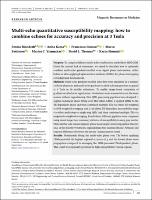| dc.contributor | Vall d'Hebron Barcelona Hospital Campus |
| dc.contributor.author | Biondetti, Emma |
| dc.contributor.author | Karsa, Anita |
| dc.contributor.author | Battiston, Marco |
| dc.contributor.author | Yiannakas, Marios |
| dc.contributor.author | Thomas, David L. |
| dc.contributor.author | Shmueli, Karin |
| dc.contributor.author | Grussu, Francesco |
| dc.date.accessioned | 2022-09-13T09:34:44Z |
| dc.date.available | 2022-09-13T09:34:44Z |
| dc.date.issued | 2022-11 |
| dc.identifier.citation | Biondetti E, Karsa A, Grussu F, Battiston M, Yiannakas MC, Thomas DL, et al. Multi-echo quantitative susceptibility mapping: how to combine echoes for accuracy and precision at 3 Tesla. Magn Reson Med. 2022 Nov;88(5):2101-16. |
| dc.identifier.issn | 1522-2594 |
| dc.identifier.uri | https://hdl.handle.net/11351/8177 |
| dc.description | MRI; Multi-echo QSM; Quantitative susceptibility mapping |
| dc.description.abstract | Purpose
To compare different multi-echo combination methods for MRI QSM. Given the current lack of consensus, we aimed to elucidate how to optimally combine multi-echo gradient-recalled echo signal phase information, either before or after applying Laplacian-base methods (LBMs) for phase unwrapping or background field removal.
Methods
Multi-echo gradient-recalled echo data were simulated in a numerical head phantom, and multi-echo gradient-recalled echo images were acquired at 3 Tesla in 10 healthy volunteers. To enable image-based estimation of gradient-recalled echo signal noise, 5 volunteers were scanned twice in the same session without repositioning. Five QSM processing pipelines were designed: 1 applied nonlinear phase fitting over TEs before LBMs; 2 applied LBMs to the TE-dependent phase and then combined multiple TEs via either TE-weighted or SNR-weighted averaging; and 2 calculated TE-dependent susceptibility maps via either multi-step or single-step QSM and then combined multiple TEs via magnitude-weighted averaging. Results from different pipelines were compared using visual inspection; summary statistics of susceptibility in deep gray matter, white matter, and venous regions; phase noise maps (error propagation theory); and, in the healthy volunteers, regional fixed bias analysis (Bland–Altman) and regional differences between the means (nonparametric tests).
Results
Nonlinearly fitting the multi-echo phase over TEs before applying LBMs provided the highest regional accuracy of and the lowest phase noise propagation compared to averaging the LBM-processed TE-dependent phase. This result was especially pertinent in high-susceptibility venous regions.
Conclusion
For multi-echo QSM, we recommend combining the signal phase by nonlinear fitting before applying LBMs. |
| dc.language.iso | eng |
| dc.publisher | Wiley |
| dc.relation.ispartofseries | Magnetic Resonance in Medicine;88(5) |
| dc.rights | Attribution 4.0 International |
| dc.rights.uri | http://creativecommons.org/licenses/by/4.0/ |
| dc.source | Scientia |
| dc.subject | Cervell - Imatgeria |
| dc.subject | Cartografia cerebral |
| dc.subject | Imatgeria per ressonància magnètica |
| dc.subject.mesh | Magnetic Resonance Imaging |
| dc.subject.mesh | Brain Mapping |
| dc.subject.mesh | Brain |
| dc.subject.mesh | /diagnostic imaging |
| dc.title | Multi-echo quantitative susceptibility mapping: how to combine echoes for accuracy and precision at 3 Tesla |
| dc.type | info:eu-repo/semantics/article |
| dc.identifier.doi | 10.1002/mrm.29365 |
| dc.subject.decs | imagen por resonancia magnética |
| dc.subject.decs | mapeo encefálico |
| dc.subject.decs | encéfalo |
| dc.subject.decs | /diagnóstico por imagen |
| dc.relation.publishversion | https://doi.org/10.1002/mrm.29365 |
| dc.type.version | info:eu-repo/semantics/publishedVersion |
| dc.audience | Professionals |
| dc.contributor.organismes | Institut Català de la Salut |
| dc.contributor.authoraffiliation | [Biondetti E] Institute for Advanced Biomedical Technologies, Department of Neuroscience, Imaging and Clinical Sciences, “D’Annunzio University” of Chieti-Pescara, Chieti, Italy. Department of Medical Physics and Biomedical Engineering, University College London, London, United Kingdom. [Karsa A, Shmueli K] Department of Medical Physics and Biomedical Engineering, University College London, London, United Kingdom. [Grussu F] NMR Research Unit, Queen Square MS Centre, Department of Neuroinflammation, UCL Queen Square Institute of Neurology, University College London, London, United Kingdom. Radiomics Group, Vall d’Hebron Institute of Oncology (VHIO), Barcelona, Spain. [Battiston M, Yiannakas MC] NMR Research Unit, Queen Square MS Centre, Department of Neuroinflammation, UCL Queen Square Institute of Neurology, University College London, London, United Kingdom. [Thomas DL] Dementia Research Centre, UCL Queen Square Institute of Neurology, University College London, London, United Kingdom. Wellcome Centre for Human Neuroimaging, UCL Queen Square Institute of Neurology, University College London, London, United Kingdom |
| dc.identifier.pmid | 35766450 |
| dc.rights.accessrights | info:eu-repo/semantics/openAccess |

